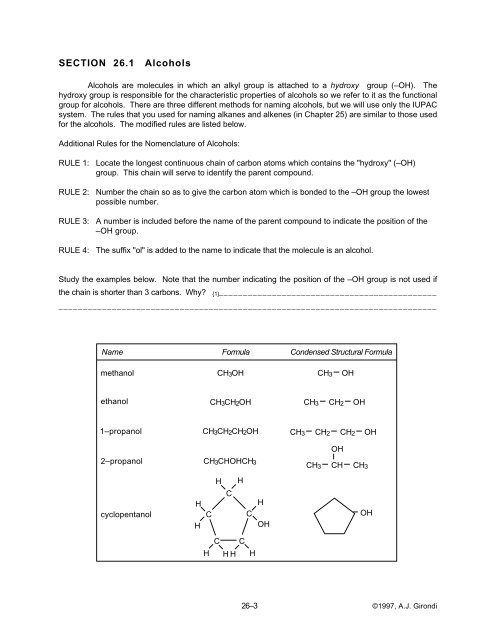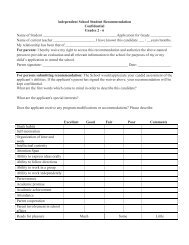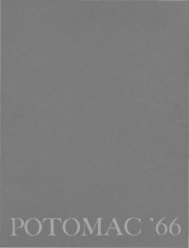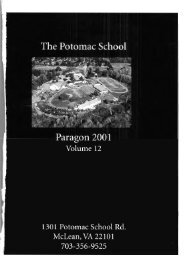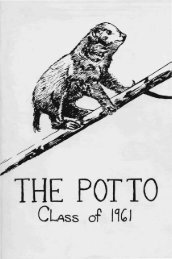Active Learning In Chemistry Education - Potomac School
Active Learning In Chemistry Education - Potomac School
Active Learning In Chemistry Education - Potomac School
Create successful ePaper yourself
Turn your PDF publications into a flip-book with our unique Google optimized e-Paper software.
SECTION 26.1<br />
Alcohols<br />
Alcohols are molecules in which an alkyl group is attached to a hydroxy group (–OH). The<br />
hydroxy group is responsible for the characteristic properties of alcohols so we refer to it as the functional<br />
group for alcohols. There are three different methods for naming alcohols, but we will use only the IUPAC<br />
system. The rules that you used for naming alkanes and alkenes (in Chapter 25) are similar to those used<br />
for the alcohols. The modified rules are listed below.<br />
Additional Rules for the Nomenclature of Alcohols:<br />
RULE 1:<br />
RULE 2:<br />
RULE 3:<br />
RULE 4:<br />
Locate the longest continuous chain of carbon atoms which contains the "hydroxy" (–OH)<br />
group. This chain will serve to identify the parent compound.<br />
Number the chain so as to give the carbon atom which is bonded to the –OH group the lowest<br />
possible number.<br />
A number is included before the name of the parent compound to indicate the position of the<br />
–OH group.<br />
The suffix "ol" is added to the name to indicate that the molecule is an alcohol.<br />
Study the examples below. Note that the number indicating the position of the –OH group is not used if<br />
the chain is shorter than 3 carbons. Why? {1} _____________________________________________<br />
______________________________________________________________________________<br />
Name Formula Condensed Structural Formula<br />
methanol<br />
CH3OH<br />
CH3<br />
OH<br />
ethanol<br />
CH3CH2OH<br />
CH3<br />
CH2<br />
OH<br />
1–propanol<br />
CH3CH2CH2OH<br />
CH3<br />
CH2<br />
CH2<br />
OH<br />
OH<br />
2–propanol<br />
CH3CHOHCH3<br />
CH3<br />
CH<br />
CH3<br />
H<br />
H<br />
cyclopentanol<br />
H<br />
H<br />
C<br />
C<br />
C<br />
H<br />
OH<br />
OH<br />
H<br />
C C<br />
H H<br />
H<br />
26–3 ©1997, A.J. Girondi


